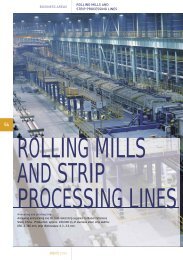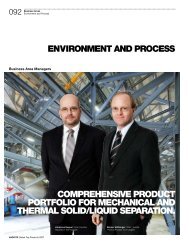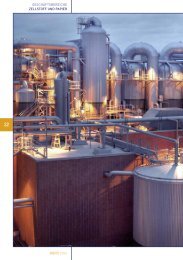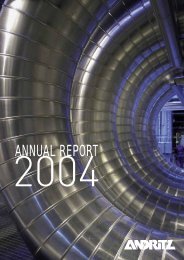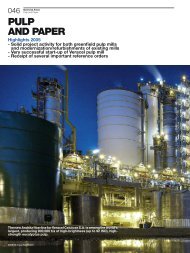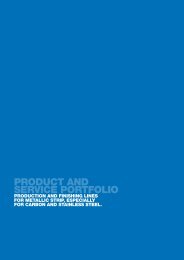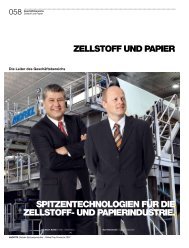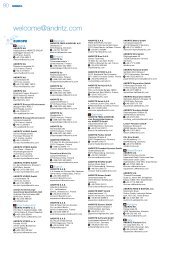Download as pdf - andritz business areas
Download as pdf - andritz business areas
Download as pdf - andritz business areas
- No tags were found...
Create successful ePaper yourself
Turn your PDF publications into a flip-book with our unique Google optimized e-Paper software.
036<br />
Customer Projects<br />
Environment and Process Business Area<br />
WHEAT FOR FUEL<br />
Interview with Antoine Pradel,<br />
Managing Director, BENP Lillebonne, Tereos Group<br />
Experience<br />
I graduated from ENITIAA in 1994, an engineering<br />
school in France, with a specialty in agro-industry<br />
and food processing. That same year, I<br />
joined Tereos <strong>as</strong> a Production Engineer for their<br />
beet sugar production facility in Origny. I became<br />
Plant Manager for the Alcohol Division at Origny<br />
and later served <strong>as</strong> Technical Director for alcohol<br />
production for the entire Tereos Group. Now,<br />
I am Managing Director of our ethanol plant in<br />
Lillebonne. France h<strong>as</strong> been one of the leading<br />
nations in Europe promoting biofuels, which are<br />
blended into g<strong>as</strong>oline. Tereos, <strong>as</strong> one of the leaders<br />
in the agro-industry, wanted to be part of this<br />
development of the biofuel industry. We invested<br />
in two large plants: one using beet <strong>as</strong> feed stock<br />
b<strong>as</strong>ed in Origny (one hour’s drive north of Paris)<br />
and one in Lillebonne b<strong>as</strong>ed on wheat.<br />
The Lillebonne project<br />
The Lillebonne plant started <strong>as</strong> a major producer<br />
of synthesized alcohol. It is located in Normandy<br />
on the banks of the river Seine, so we have to<br />
respect the most stringent environmental regulations.<br />
In 2007, we completed a project to add<br />
a wheat-b<strong>as</strong>ed ethanol production facility at Lillebonne.<br />
While there are many bioethanol plants in<br />
operation in the world, most use corn <strong>as</strong> a feed<br />
stock. So, that makes Lillebonne a bit unique in<br />
using wheat <strong>as</strong> the feed stock – and one of the<br />
largest in the world. Every year, it can convert<br />
820,000 tons of wheat into 300,000 m 3 of ethanol<br />
and 300,000 tons of distillers’ grain for animal<br />
feed. The w<strong>as</strong>te streams from the whole plant are<br />
received by a w<strong>as</strong>tewater treatment plant, with<br />
the same capacity of a town of 250,000 people.<br />
There, a methanization process produces biog<strong>as</strong><br />
used <strong>as</strong> a fuel for our turbine that powers<br />
the plant.<br />
Selection of Andritz<br />
I w<strong>as</strong> familiar with Andritz from my time at the<br />
Origny plant. We had two Andritz decanter centrifuges<br />
running in parallel with another unit from<br />
a major European manufacturer. This gave us the<br />
opportunity to evaluate their performance and<br />
reliability. We also visited the Andritz installation<br />
at the Valenton w<strong>as</strong>tewater treatment plant near<br />
Paris. There we saw five large decanters running<br />
24/7 and feeding two Andritz drum dryers. The<br />
simple operation of these machines, the reliability,<br />
and the low maintenance requirements were<br />
confirmed to us by the operating managers of<br />
the Valenton plant. What w<strong>as</strong> most important<br />
for us at the end of the day w<strong>as</strong> the quality of<br />
service. This w<strong>as</strong> a key re<strong>as</strong>on to select Andritz<br />
technology.<br />
The Andritz scope<br />
Andritz technology is involved in several stages<br />
of the process. At the beginning, up to 140 tons<br />
per hour of wheat are ground into whole flour.<br />
Andritz supplied two double-shaft mixers to mix<br />
this flour with liquid and other products into a<br />
slurry that goes to ferment. After fermentation,<br />
the alcohol is then separated by distillation. The<br />
remaining material (whole stillage) contains water<br />
and unfermented organic matter (bran, proteins).<br />
These fibers, along with the dissolved protein, are<br />
used to produce a high quality animal feed product.<br />
Thus, the first stage is to separate the solids<br />
from the liquid ph<strong>as</strong>e (thin stillage) <strong>as</strong> efficiently <strong>as</strong><br />
possible. Andritz supplied seven large decanter<br />
centrifuges from their D7 Series to carry out this<br />
critical separation step. The centrifuges have a<br />
large diameter of 750 mm and are equipped with<br />
parts specially designed for this application such<br />
<strong>as</strong> the scroll conveyor, capable of high capture<br />
rates of the insolubles solids and high dryness<br />
for the solids separated. Additionally, a special<br />
energy recovery system developed by Andritz<br />
reduces the power absorbed by the centrifuges.<br />
Finally, Andritz also delivered more than 100 centrifugal<br />
pumps of various sizes installed throughout<br />
the process.<br />
The project schedule<br />
The project schedule w<strong>as</strong> very tight and I believe<br />
we have established a record. From the<br />
first stages of procurement to the start-up w<strong>as</strong><br />
only 14 months. We built the plant in less than<br />
nine months. In May 2007, we started up the<br />
plant for the first time; within 15 days we had<br />
commissioned all the different process units. After<br />
one-and-a-half months, we were at 80% of<br />
the production capacity of the plant. Andritz is<br />
a very good supplier. They were very competitive<br />
from the beginning and delivered what they<br />
promised on time. This w<strong>as</strong> critical for the success<br />
of our project given the very short construction<br />
period.<br />
Performance<br />
We were expecting a very e<strong>as</strong>y start-up and adjustment<br />
of the centrifuges in order to produce<br />
<strong>as</strong> quickly <strong>as</strong> possible. The Andritz equipment<br />
h<strong>as</strong> been available and performing well since the<br />
first day we put product in it. The performance<br />
and mechanical reliability of the machinery is topnotch.<br />
We have been running every day at the<br />
maximum capacity possible in order to meet our<br />
customers’ expectations. The quality of service is<br />
also very high. Andritz engineers and technicians<br />
are highly skilled professionals and they listen to<br />
the needs of our crews. This makes a big difference<br />
at the end of the day. We know our process<br />
best and Andritz knows its technology best. By<br />
working together <strong>as</strong> trustworthy partners, both<br />
of us benefit.<br />
ANDRITZ Global Top Products 2007



